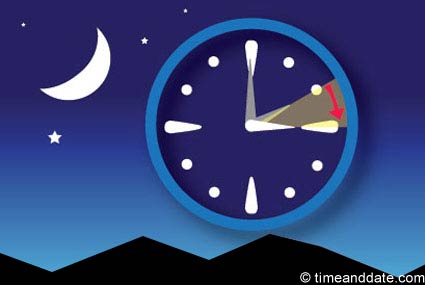Ok, folks, here comes that one day sure to screw up your life for at least 24 hours, if not the entire week: Daylight Savings Time 2011.
That’s the day, Sunday, November 6, 2011, when you have to set your clocks forward – not backward – one hour. (Remember, that’s one week from now.)
That little fact is lost on many, and results in people like this blogger, forgetting to adjust their clocks.
Fortunately, we have smartphones to do that for us. And if you’re anything like this blogger, you use your smartphone, in this case an Apple iPhone as your watch. (It’s a more complicated physical process, reaching for the iPhone versus twisting and looking at the wrist, but it does the job.)
But even with that, what confuses many is what time it is with respect to what they have to do, and when they wake up. That hour time difference just plain feels different and takes about a week to get used to.
So with all of that hassle, the question is, do we have to do this? Many say it helps to save energy, and that it was started in World WarI to save fuel by reducing the need to use artificial light.
But others say it’s unnecessary to have to do Daylight Savings at all.
My take is, given the way we work in an Internet age, I’m not sure Daylight Savings is the big energy saver it was in a time before the information age.
Moreover, this paragraph offers another reason not to do it, at least in the way we’re used to:
The Uniform Time Act of 1966 provided the basic framework for alternating between daylight saving time and standard time, which we now observe in the United States. But Congress can’t seem to resist tinkering with it. For example, in 1973 daylight saving time was observed all year, instead of just the spring and summer. The current system of beginning DST at 2 AM on the first Sunday in April and ending it at 2 AM on the last Sunday in October was not standardized until 1986.
So, all of this is government-directed. That means we can elect to stop doing it all together. But until we do, remember that on November 6, clocks go forward one hour.
Oh, I mean back. See, I’m so confused!
What a pain.
What is Daylight Saving Time?
Daylight Saving Time (or summertime as it is called in many countries) is a way of getting more light out of the day by advancing clocks by one hour during the summer. During Daylight Saving Time, the sun appears to rise one hour later in the morning, when people are usually asleep anyway, and sets one hour later in the evening, seeming to stretch the day longer.

Many locations in the world set their clocks from 2am (or 02:00) to 3am (or 03:00) in their local times when they begin daylight saving time. However, some places change their clocks at other times, depending on the daylight saving time rules.

Many locations in the world set their clocks from 2am (or 02:00) to 3am (or 03:00) in their local times when they begin daylight saving time. However, some places change their clocks at other times, depending on the daylight saving time rules.
When Do the Clocks Change?
Northern Hemisphere
Daylight saving time begins in the northern hemisphere between March–April and ends between September–November. Standard time begins in the northern hemisphere between September–November and ends between March–April. Many countries in the northern hemisphere may observe DST.
Southern Hemisphere
Daylight saving time begins in the southern hemisphere between September–November and ends between March–April. Standard time begins in the southern hemisphere between March–April and ends between September–November. Many countries in the southern hemisphere may observe DST.

